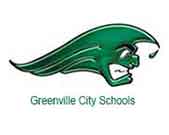|

 |
Greenville City Schools
For the Love of Science
Kitty Davis, Greenville Elementary Principal
Mrs. Sherry Flora has taught for Greenville Elementary for almost three
decades. During this time, she has educated many elementary students in
the area of science. Mrs. Flora is a scientist at heart- from the time
of seventh grade when she burned a peanut in a can to determine the
amount of calories it possessed. As she entered college, Mrs. Flora
focused on sharing her love for science with others and decided to
pursue a degree in education.
Her thirst for knowledge regarding archeological digs started in the
mid 1990s in Ansonia. Mrs. Flora recalled that a mastadon’s tooth was
caught in a farmer’s plow. Soon the field became a digging site in
conjunction with an Ohio university and about a dozen teachers. The
bones were not well preserved as they were located in the surface of
the topsoil. Therefore, the fragments were plastered prior to being
removed from the dirt with brushes and shovels. Mrs. Flora explained
that it was a “semi-scientific” dig as the findings were not measured
in depth or mapped. She recalled finding teeth and ribs, and to this
day, she still has rough chunks of mastadon bone.
In the summer of 2014, Mrs. Flora traveled to La Crosse, Wisconsin as
part of the National Endowment for Arts grant to participate in another
dig. Upon arrival, the land had been cleared of the grass for the
participants. A team of thirty people worked in small groups to remove
two layers of soil. They utilized shovels, brushes, large sifters, and
other small tools to remove arrowheads, pottery, and other early
remnants of the Mound Builders. The area was measured and mapped to
include the depth of where the fossils were found. The samples were
then bagged and labeled prior to being sent to a laboratory for further
research.
Beginning in 2016, Mrs. Flora integrated her passion for archeological
digs and literature into the classroom. She began by having students
read the book, “Mary Anning and The Sea Dragon” so they could gain
background knowledge of the role of a paleontologist. Students then
learned about how scientific digs were performed through videos,
textbooks, and lectures. Later, students received a fictitious letter
from a university professor, “Dr. Brown,” who needed their assistance
on a fossil dig as all other paleontologists were out of the country.
Student teams were formed and given the task of deciding how they would
present the findings to “Dr. Brown.”
The planning sheets included measuring and mapping the location of the
fossils as well as organizing the fossils. The teams then chose the
utensils (toothpicks, tooth brushes, paint brushes, and sifters) to
uncover the fossils in layers of soil and sand contained in square
tubs. After making notes and taking pictures of the fossils on their
iPads, materials were referenced regarding their findings. Since the
fossils were all classified as underwater fossils, the correct
conclusion drawn in the final report from the teams was that this
portion of Ohio was previously an ocean or large river. Students were
excited to get to keep some of the fossils and had so much fun that
this activity has become an annual event for fourth graders. Mrs. Flora
also has aspirations to engage in another archeological dig soon- all
for the love of science.
|
|
|
|

